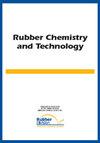A MICROSCOPY INVESTIGATION OF RUBBER COMPOUND CRACK PRECURSORS AND TENSILE FRACTURE SURFACES
IF 1.5
4区 工程技术
Q4 POLYMER SCIENCE
引用次数: 0
Abstract
Tensile stress-strain testing is used to investigate fracture behavior of carbon black-reinforced styrene-butadiene rubber, using 50 replicate specimens. Four vulcanized rubber compounds are studied: a CB-filled SBR with standard mixing conditions (Control); the same formulation with intentional poor mixing of the CB; and materials identical to the control material but formed by adding minor amounts of 0.5 mm diameter glass microspheres (beads) – serving as large model defects/inclusions - using a two-roll mill at two levels corresponding to average values of 0.78 and 6.24 beads per gauge section region of the tensile test specimen. This paper focuses on microscopy analysis of the resulting fracture surfaces to complement our recent publication on Weibull failure statistics for distributions of tensile strength and crack precursor size (Polymers 12, 203 (2020)). All 200 fractured specimens from tensile testing at 23°C are imaged with light microscopy and exhibit fracture surfaces that are characterized by relatively smooth planes that are perpendicular to the uniaxial loading direction. The majority of tensile failures originate from the edges of the dumbbell specimens, in line with expectations from fracture mechanics. Light microscopy reveals concentric fracture ring features of high specular reflectance emanating from crack precursors, which are a universal feature of the failure process for these compounds and independent of precursor type, size, or location. Non-contact interferometric microscopy confirms that the rings are the result of variations in surface micro-roughness; proceeding outwards from the precursor as rough-smooth-rough to the edge of the fracture surface. Fracture rings are also observed for tensile tests performed at 80°C. The variation in surface roughness of the fracture surface has parallels to the stick-slip tearing behavior seen for rubbers torn at medium to high rates. To the best of the authors’ knowledge, this is the first time that such striking features have been reported.橡胶复合裂纹前兆及拉伸断口的显微研究
采用拉伸应力应变试验研究了炭黑增强丁苯橡胶的断裂行为。研究了四种硫化橡胶化合物:在标准混合条件下(对照)填充cb的SBR;同样的配方,故意不混合炭黑;以及与对照材料相同的材料,但通过添加少量0.5 mm直径的玻璃微球(珠子)形成-作为大型模型缺陷/夹杂物-使用两辊轧机在两个水平上形成,对应于拉伸试样的每个规范截面区域的平均值为0.78和6.24个珠子。本文的重点是对所产生的断裂面进行显微分析,以补充我们最近发表的关于拉伸强度和裂纹前体尺寸分布的Weibull失效统计(Polymers 12,203(2020))。在23°C下进行拉伸试验的所有200个断裂试样都用光学显微镜成像,并显示出垂直于单轴加载方向的相对光滑的断口表面。大多数拉伸破坏源自哑铃试样的边缘,这与断裂力学的预期一致。光学显微镜显示了由裂纹前体发出的高镜面反射的同心圆断裂环特征,这是这些化合物破坏过程的普遍特征,与前体类型、大小或位置无关。非接触式干涉显微镜证实,这些环是表面微粗糙度变化的结果;从前驱体向外依次为粗-光滑-粗至断裂面边缘。在80°C的拉伸试验中也观察到断裂环。断口表面粗糙度的变化与中高速撕裂橡胶的粘滑撕裂行为相似。据作者所知,这是第一次报道如此显著的特征。
本文章由计算机程序翻译,如有差异,请以英文原文为准。
求助全文
约1分钟内获得全文
求助全文
来源期刊

Rubber Chemistry and Technology
工程技术-高分子科学
CiteScore
3.50
自引率
20.00%
发文量
21
审稿时长
3.6 months
期刊介绍:
The scope of RC&T covers:
-Chemistry and Properties-
Mechanics-
Materials Science-
Nanocomposites-
Biotechnology-
Rubber Recycling-
Green Technology-
Characterization and Simulation.
Published continuously since 1928, the journal provides the deepest archive of published research in the field. Rubber Chemistry & Technology is read by scientists and engineers in academia, industry and government.
 求助内容:
求助内容: 应助结果提醒方式:
应助结果提醒方式:


